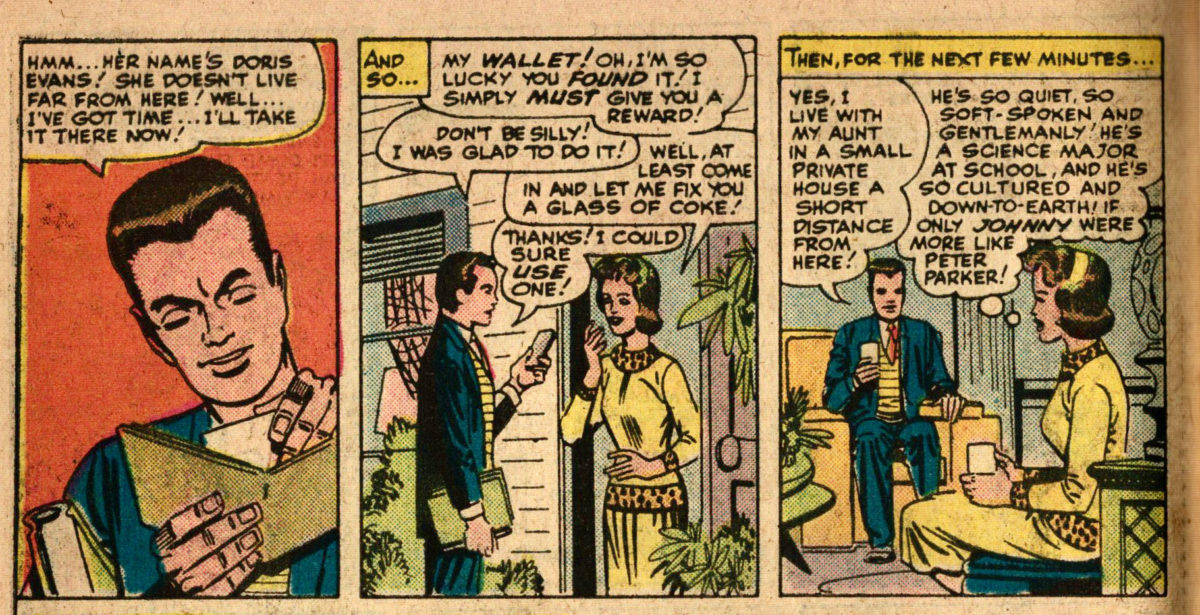Featuring: Marvels
Release: December 14, 1993
Cover: February 1994
$5.95
Writer: Kurt Busiek
Artist: Alex Ross
Letterers: Starkings w/ John Gaushell
Editor: Marcus McLaurin
Assitant editor: Spencer Lamm
Editor in Chief: Tom DeFalco
Cover design & logo: Joe Kaufman
Interior design: Comicraft
45 pages
| Previous | Next | |
|---|---|---|
| Weird Science #20 | PRELUDE | |
| Tales of Suspense #72 | Reading order | Sgt. Fury #22 |
| Marvels #1 | Marvels | Marvels #3 |
The real story was the people who’d been scared too long. Who’d been wound tight by talk of mutant menaces and hidden conspiracies and shadows under the bed.

I’ve mentioned before I want to frame our reading around the Marvels miniseries from the 1990s. That hasn’t really been obvious yet. We read Marvels #0, which retold a few pages from Marvel Comics #1. And we read Marvels #1, which paralleled 1940s Marvel comics. But our reading is concentrated in the 1960s. Finally, we get to Marvels #2, which parallels the 1960s Marvel stories, ranging from Avengers #6 (May 1964), the 191st entry in our reading, through Tales of Suspense #69 (June 1965), the 404th entry in our reading. Quite the range. We are reading it after completing the Iron Man story from Tales of Suspense #72, because we’d first needed to tie up some continuity ends.
We’ve hinted before at the theme of this comic, and I’d like to just discuss it up front. The two centerpiece stories are the wedding of Reed and Sue in Fantastic Four Annual 3, and the attack on the X-Men by the Sentinels in X-Men #14. The writer Kurt Busiek had noted in his own Marvel Universe research what we also found in our reading here, that these events must occur on nearly consecutive days. That’s not obvious from any comic, but does follow from a close reading of the many interconnected comics. And the two stories make for quite the juxtaposition.
The contrast between these two arcs becomes the central tension of this issue. The Fantastic Four wedding is the celebrity event of the century. The press covered it, crowds of fans gathered, famous people like Tony Stark and Millie the Model attended. The Fantastic Four are super-powered heroes and beloved by the public.
The X-Men are also super-powered heroes. But where the Fantastic Four gained their powers from cosmic radiation, the powers of the X-Men are innate, based on an accident of birth, perhaps from radiation their parents had been exposed to. The “Children of the Atom”. And that difference is big enough that the same public who cheered on the wedding of the FF members would listen with interest and nods of approval as Bolivar Trask went on the airwaves to declare mutants a menace and announce he’d created robot-hunting Sentinels to hunt and kill the X-Men.
We read the Heroes & Legends retelling of the wedding, which focused on this very tension in the form of a child, who was a huge fan of the Fantastic Four, but afraid of the X-Men. He learned better by issue’s end.
Here, the arc will play out within Phil Sheldon, the photojournalist who specialises in shots of the people he’s dubbed the Marvels. A person who idolizes heroes like the Fantastic Four and Avengers, but fears mutants like the X-Men.
It’s entirely irrational, just like all forms of bigotry.
That’s enough belaboring of themes. Let’s dive into the story. As we do, we’ll try to draw the parallels between what’s happening on the page and our reading.
I’ll note that the title is called “Monsters”, which brings to my mind Thing and Hulk. The latter doesn’t appear, and the former is a minor player at best.
It’s 20 years after the events of Marvels #1. Phil Sheldon is now an established freelance photojournalist happily married with two kids. We see hm doing freelance work for Barney Bushkin at the Daily Globe. The shadows on the page somewhat obscure Phil’s eyepatch, a lifelong injury sustained last issue by getting too close to a superhero battle.

We remember meeting Barney in Amazing Spider-Man #27. He’s nicer than Jonah, but asked too many questions for Peter’s tastes.
Continue reading “POSTLUDE: Marvels #2”
































